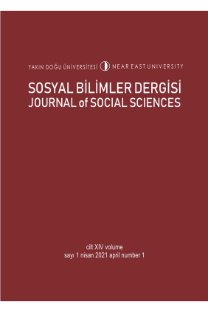The oppositions in Edward Albees' the zoo story
Çok sayıda ikilemlerin varlığı Edward Albee’nin birçok oyununu karakterize eder. Yazar, bu ikilemlerin varlığını sadece ifade etmenin de ötesine giderek, bunların günlük yaşamda sahip oldukları fonksiyonları vurgular. Bu gerçekten kaçınmanın hiçbir sorunu çözmediği, yapıtlarının ana temalarından birisidir. Dahası, birey bir adım öteye gitmeli, bu kaçınılmaz durumu kabullenmeli ve hatta kucaklamalıdır. Yazarın en önemli temalarından birisi de, yaşarken aslında manen ölü olduğumuzdur. Yaşam ve gerçek insanlığın bir gerçeği ve yaşamın her anında birlikte yürüyen iki olgudur. Ancak bu durum genel olarak insanlık tarafından olduğu gibi onun karakterlerince de görmezlikten gelinmektedir. Yazar, okuyucunun bu durumun farkına varması ve bunu kabullenmesi için çaba gösterir. Bu yazıda, Hayvanat Bahçesi Masalı oyunundaki ikilemleri örnekler vererek incelemeye ve bunların hem oyunda hem de günlük yaşamda ne denli etkili olduğunu ortaya koymaya çalışacağız.
An abundance of contradictions characterizes most of Edward Albee’s plays. The playwright emphasizes the crucial function of contrasts in everyday life going beyond just expressing them. The playwright reveals that one has to live with such opposites as black and white, good and bad closely since it is not possible to avoid them. Moreover, one should go one step further and accept this unavoidable situation even embracing this contradictory situation. As an example, that we are spiritually dead, while living, is one of his most important themes. Life and death, in fact, are realities of humanity, close to each other, going hand in hand any moment in life. But this is persistently ignored by his characters as well as by mankind in general. The playwright tries hard to make the reader be aware and acknowledge that this is the case. Therefore, we will try to examine the contradictions in The Zoo Story, give examples, and reveal how influential they are in the play as well as in real life.
___
Albee, E. (1995). "The Zoo Story." American Drama: Colonial to Contemporary. eds. Stephen Watt and Gary A. Richardson. Orlando: Harcourt Brace & Company.Amacher, R. E. (1982). Edward Albee. Boston: Twayne Publishers.
Hayman, R. -(1971). Contemporaiy Playwrights: Edward Albee. London: Heinemann.
Miller, G. (1986, Summer). "Albee on Death and Dying: Seascape and The Lady from Dubuque." Modern Language Studies. Vol. 16, No. 3. pp. 149-160.
Ringsley, L. (1973, March). "Reality and Illusion: Continuity of a Theme in Albee." Educational Theatre Journal. Vol. 25, No. 1. pp. 71-79.
Robb, J. C. (2002, Sept 4). Philadelphia Weekly, http://www.lunatheater.org/ press.htm
Poggenburg, R. P. (1989). Introduction to: Charles Baudelaire: Une Micro-Histoire. http://www.library.vanderbilt.edu/baudelaire/englishintro.html
Stenz, A. M. (1978). Edward Albee: The Poet of Loss. New York: Mouton.
Zimbardo. R. A. (1975). "Symbolism and Naturalism in Edward Albee's The Zoo Story." Edward Albee: A Collection of Critical Essays, ed. C. W. E. Bigsby. Englewood Cliffs, NJ: Prentice-Hall.
- ISSN: 1986-1303
- Yayın Aralığı: Yılda 2 Sayı
- Başlangıç: 2008
- Yayıncı: Yakın Doğu Üniversitesi
Sayıdaki Diğer Makaleler
The oppositions in Edward Albees' the zoo story
Mediating international conflicts
Küresel Siyaset ve çokkültürcülük
Kosova krizinde Türkiye'nin dış politikası
Öğrenme ve değişim ( kendini değerlendirme çalışması)
ERDAL BAY, Şerafettin KARAKAYA, Aysun YEŞİLKURT
II. Abdülhamit'in jön Türk siyaseti: İttihat ve Terakki Cemiyeti'ne karşı önlemler
